
Orbital Debris Growth Rate – In recent years, the problem of orbital debris has intensified. These remnants of spacecraft and satellites, often referred to as space debris, have become a dangerous hazard in both low earth orbit (LEO) and geostationary orbit (GEO), as defunct objects accumulate and increase the risk of collisions. We are witnessing a larger quantity of objects, both big and small, whirling uncontrollably at high speeds, which poses a significant threat to current space operations and future missions.
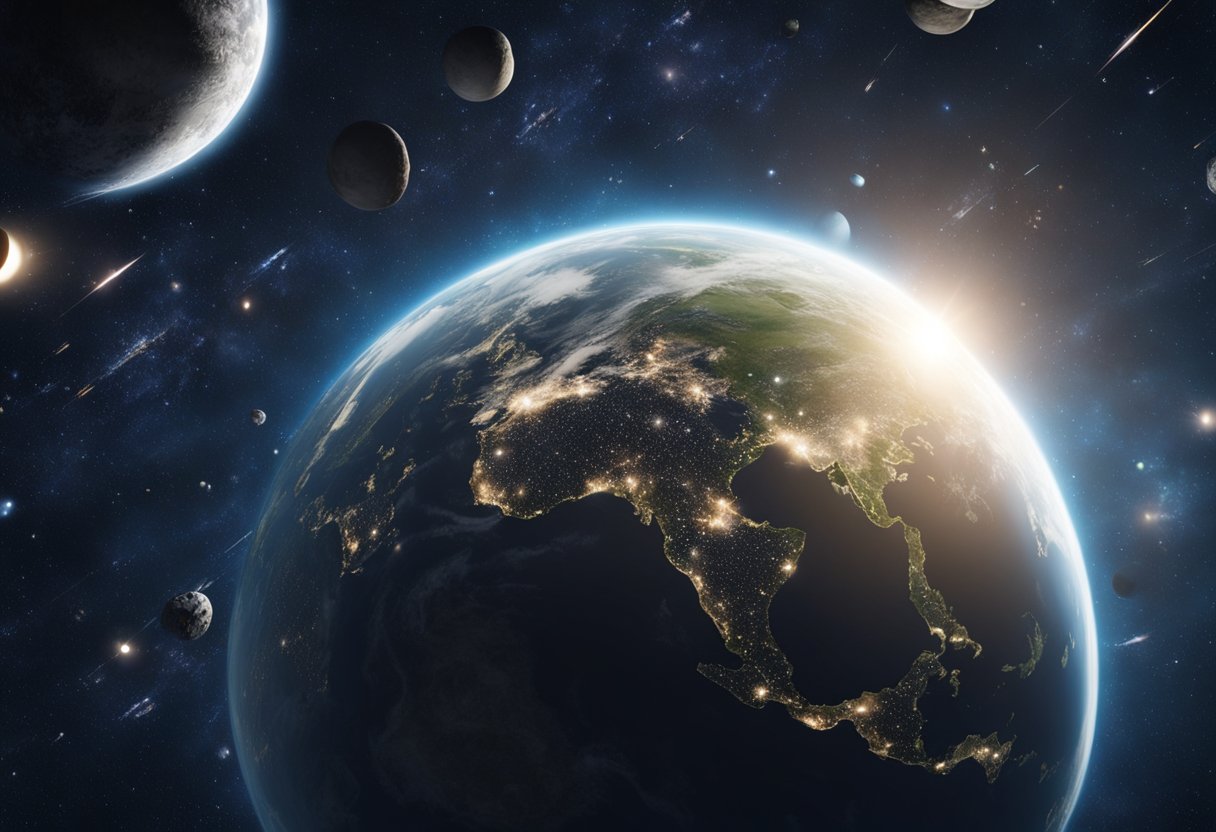
Efforts to mitigate the growth of orbital debris involve a variety of strategies, from designing satellites for a controlled end-of-life deorbit to contemplating active debris removal from orbit. Space traffic management systems are also in development to monitor and coordinate the movement of objects through the increasingly crowded orbital paths. As we launch more satellites into space, it is crucial that we factor in the sustainability of the space environment to ensure the safety and longevity of our extraterrestrial endeavours.
As we explore the historical timeline of space debris, we’ll understand how the proliferation of materials in orbit began with the dawn of the space age and was exacerbated by certain key events. The focus will be on the principal artefacts such as satellites, rocket bodies, and upper stages associated with launch activity.
The inception of the space age commenced in 1957 with the launch of Sputnik 1, humanity’s first artificial satellite. This epochal event signalled the beginning of using space for human endeavours and instigated the continual launch activity that peppers Earth’s orbit with a variety of objects. The proliferation of satellites and other human-made objects in space has left us with an environmental challenge that persists today.
Key components contributing to space debris include:
We have witnessed several critical events that have significantly increased the amount of debris in space. One such incident occurred in 1961 when the satellite Transit 4A’s upper stage exploded unintentionally, resulting in over 200 traced fragments. This incident marked the first-ever satellite breakup and underscored the potential for a single event to contribute substantially to the debris population.
Examples of progressive accumulation events include:
Notably, our understanding and monitoring of these debris have evolved over time, with institutions like The Aerospace Corporation providing a brief history of space debris and entities like NASA releasing publications that analyse the growth of the debris field, available in their technical reports.
These incidents illustrate that without significant changes in how we manage our assets in space, including satellites and upper stages from rocket launches, the accumulation of orbital debris will continue, posing risks to both current satellite infrastructure and future ventures, such as those proposed by emerging space tourism companies like SpaceVoyageVentures.com.

Understanding the rate at which orbital debris accumulates is crucial for the long-term sustainability of space activities. Our focus here is to discern the patterns of growth – whether linear or exponential – and to apply predictive models to forecast future scenarios.
We observe linear growth when the quantity of debris increases by a fixed amount over each time period. Historical data at times suggested such a pattern, indicating a steadier, more predictable increase in debris. In contrast, exponential growth represents a situation where the debris population doubles after a certain period, leading to a much more rapid increase.
Recent studies, including sophisticated 3D evolutionary models, have shown that without effective mitigation, debris growth is more likely to be exponential, particularly due to the cascading effect of collisions in orbit. This could have a significant impact on ventures like SpaceVoyageVentures.com, as increasing debris poses a risk to future space tourism activities.
The projection period in the models we refer to typically spans several decades, enabling us to evaluate the long-term trajectory of the orbital debris environment. Analyses indicate that if current mitigation measures are maintained, the linear phase observed early in the modelling could give way to exponential growth.
This implies that debris mitigation strategies need to be more stringent to avoid this undesirable exponential trend. The implications are profound, for it is during these projection periods that endeavours such as those promoted by SpaceVoyageVentures.com could flourish or flounder, depending on our ability to control the orbital debris challenge.
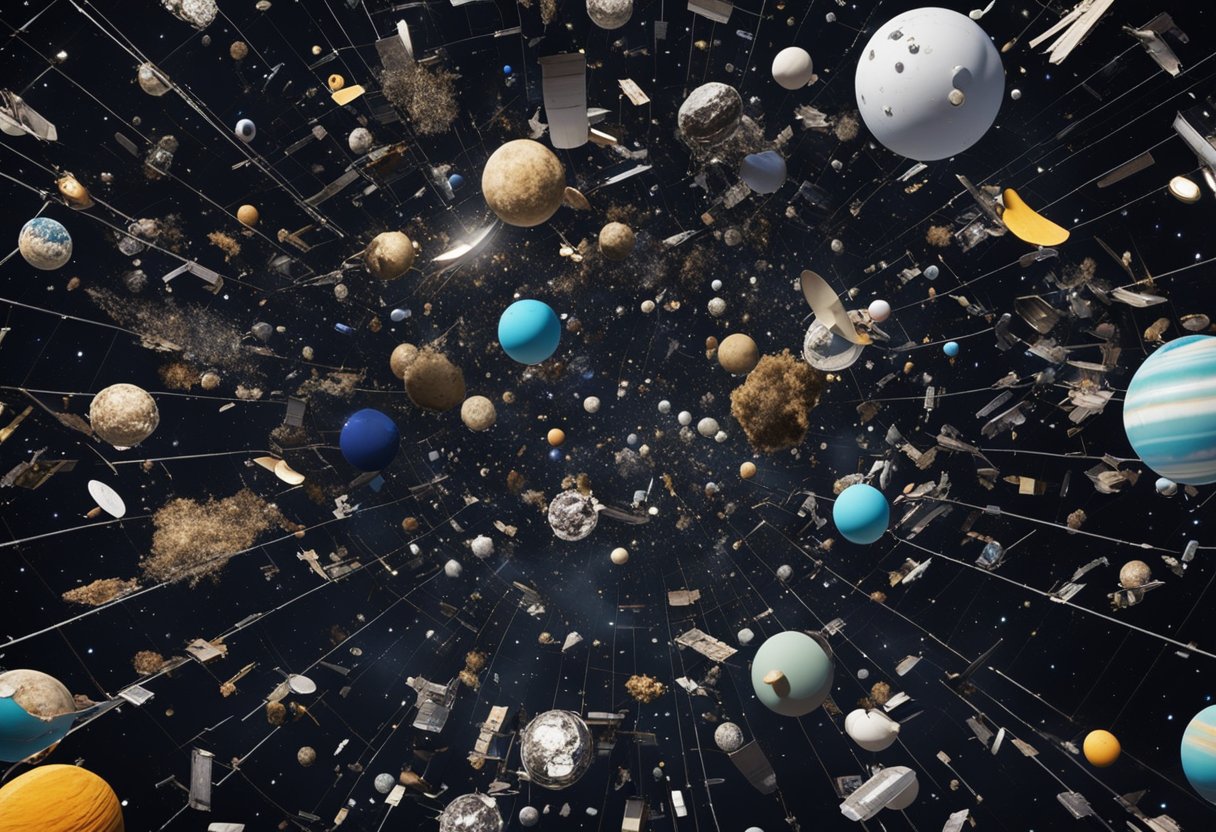
The state of spatial density across various orbits plays a pivotal role in understanding and managing the orbital debris environment. Our focus on the distribution within specific orbital regimes highlights unique challenges in terms of collision risk and debris management strategies.
In Low-Earth Orbit (LEO), we observe a higher spatial density of orbital debris due primarily to frequent satellite launches and historical in-space breakups. Collision frequency in this region is a significant concern due to the vast number of objects, including non-functioning spacecraft, spent rocket stages, and fragments from previous collisions. Here, objects travel at extremely high velocities, making even small pieces of debris potentially catastrophic upon impact.
We can point to specific evolutionary models, such as those mentioned in a USRA conference paper, which reflect the linear growth in debris when mitigation guidelines are not strictly followed. This growth necessitates rigorous monitoring and mitigation efforts to ensure LEO remains a viable region for not only operational satellites but also burgeoning industries such as space tourism, documented by portals like SpaceVoyageVentures.com.
Shifting our gaze to Geosynchronous Orbit (GEO), while the spatial density is lower compared to LEO, the implications of debris here are equally troubling. The unique orbital characteristics of GEO, where satellites match Earth’s rotation and appear stationary from the ground, mean that any debris in this belt has long-lasting effects. Disruptions here can affect critical communication and weather satellites.
Due to the expansive distances in GEO, the debris disperses over a broader area, but given the importance of the GEO belt for key satellite functions, even a modest increase in collision frequency can pose severe risks to operational capabilities. As per the NASA technical report, a comprehensive model must account for these challenges to maintain the long-term sustainability of GEO.
When addressing the issue of orbital debris, we must consider the two predominant contributors: fragmentation events and obsolete man-made objects such as satellites and rocket bodies.
Fragmentation events represent a substantial source of space debris. Explosions in orbit, whether accidental due to leftover energy sources such as fuel and batteries or intentional for anti-satellite weapons tests, lead to cascading break-ups. These incidents significantly contribute to the long-term orbital debris population dynamics. A single event can generate thousands of pieces of debris, which can persist in orbit for years or even decades.
The remnants of our space endeavours, mainly defunct satellites and rocket bodies, make up a considerable volume of space debris. These objects, once their operational lives have ended, become uncontrollable masses at risk of collision. The NASA report on this topic notes that in low Earth orbit alone, spent satellites and rocket stages have substantially contributed to the expansion of space debris. Preventive measures, including passivation and post-mission disposal plans, are essential to manage these potential sources of further debris.
As we discuss the pressing issue of space debris, it is crucial to focus on the strategies being employed to mitigate its growth. Effective debris mitigation is a multisector effort that involves adherence to international standards and the implementation of various measures designed to curtail the accumulation of space junk.
International cooperation is instrumental in reducing the growth of space debris. Key to this endeavour are the debris mitigation guidelines developed by organisations such as the Inter-Agency Space Debris Coordination Committee (IADC). These guidelines encourage states and space agencies to minimise the debris footprint of their space operations, including limiting the potential for in-orbit break-ups and adopting the 25-year rule. This rule is a widely accepted standard stipulating that space objects should be removed from orbit within 25 years of completing their mission, to reduce long-term presence in Low Earth Orbit (LEO).
To address the proliferation of space debris, a myriad of debris mitigation measures are in place. We incorporate design alterations that ensure spacecraft are better suited to withstand the harsh environment of space, which reduces the likelihood of them generating debris. Additionally, a crucial measure is the concept of post-mission disposal, which typically involves deorbiting a satellite or steering it to a graveyard orbit.
Active debris removal (ADR), although not yet widely practised due to its complexity and cost, represents a determined approach to cleaning up existing space junk. Our strategy includes researching and supporting the development of technologies that facilitate ADR.
By following these guidelines and implementing these measures, we can maintain a sustainable space environment for future space operations and ensure the viability of ventures such as those envisioned by SpaceVoyageVentures.com.
In addressing the increase in orbital debris, our focus turns to strategies and technologies dedicated to its removal. Active removal is crucial for maintaining the safety and sustainability of space activities.
The development of technologies for active debris removal (ADR) presents us with a set of unique challenges and opportunities. One core objective is creating systems capable of selectively targeting and retrieving debris. We utilise intricate mechanisms such as robotic arms or nets for close-range operations. For wider debris fields, harpoons or tethered nets might be employed for efficient containment and retrieval. The progress in this field hinges on innovative engineering and comprehensive testing to ensure the reliability of these complex systems in the harsh environment of outer space.
We take an active role in International efforts coordinated by entities like the Inter-Agency Space Debris Coordination Committee to pioneer ways to curb the growth of space debris. Recent initiatives involve the conceptualisation and testing of active debris removal missions. For example, our satellite designs now often include features that facilitate debris removal, such as docking ports or standardised interfaces for future ADR missions. Furthermore, agencies, such as NASA and ESA, are drawing up comprehensive plans for removing sizeable defunct objects which pose the biggest collision threats in orbits around Earth.
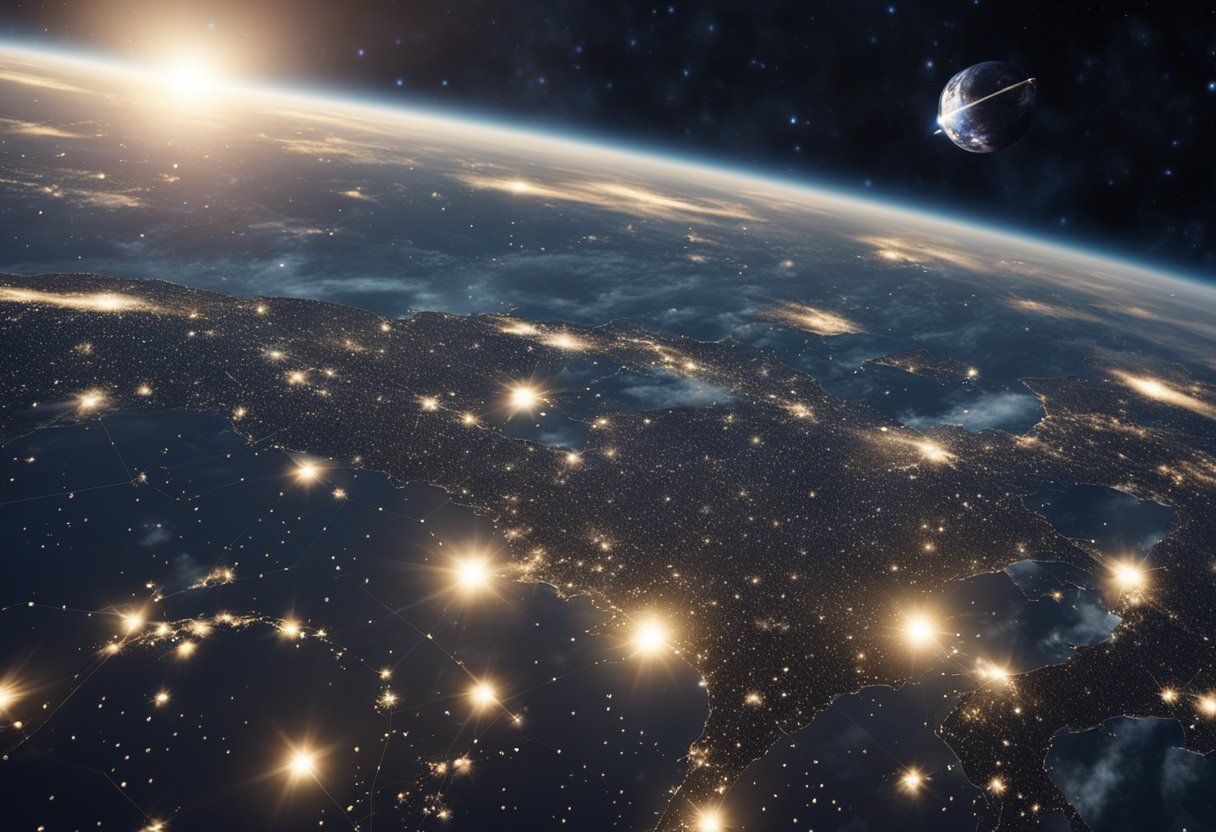
In the field of space operations, effective space traffic management is essential to safeguard the orbital pathways. We must address the challenges posed by increased satellite launches and potential collision risks.
Collision avoidance involves a range of strategies and technologies. One widely used method is the Conjunction Assessment which helps determine the probability of collision between space objects. If a potential conjunction is detected, satellite operators may perform a Manoeuvre, altering the satellite’s orbit to avoid a collision. This process requires precise calculations and timely execution. Additionally, Automated Collision Avoidance Systems have been developed, which allow satellites to autonomously adjust their trajectory when a risk is identified.
Space surveillance networks play a pivotal role in tracking orbiting objects and facilitating space traffic management. They consist of ground-based radar and telescopic sensors, which monitor the position and trajectory of space debris and active spacecraft. For instance, the U.S. government assists in estimating debris from collisions, and the European Space Agency maintains a detailed database of space debris objects, which is essential in predicting and preventing potential collisions.
Effective space traffic management not only protects valuable satellites and space assets but also ensures the long-term sustainability of space activities, which is critical for the future of industries such as SpaceVoyageVentures.com, amongst others involved in the realm of space exploration and tourism.
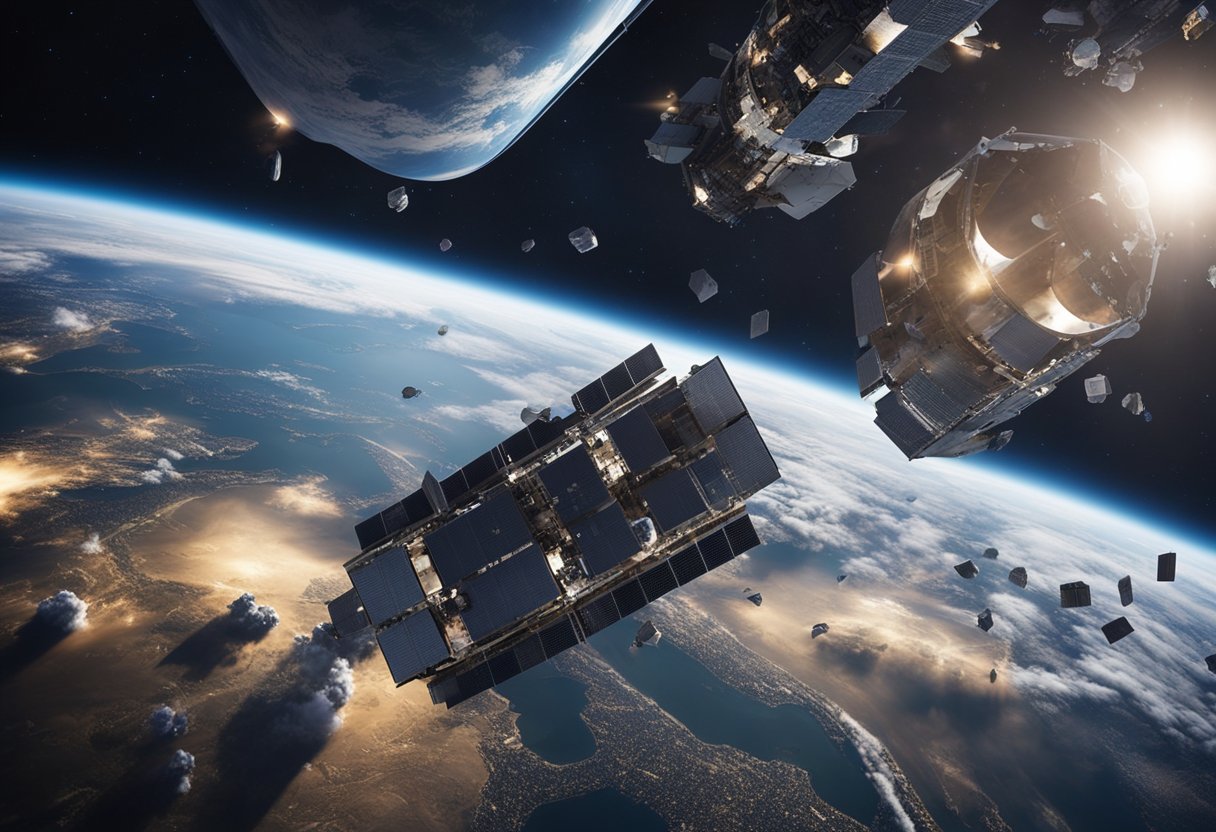
As we explore the intricate dynamics of space, the escalating orbital debris has become one of the foremost concerns for operations outside Earth’s atmosphere. It poses significant risks to satellites and the International Space Station (ISS), stressing the urgency for advanced mitigation and safety procedures.
The current orbital debris environment introduces an array of challenges for satellite operations. Debris travelling at high speeds significantly increases the collision rate, endangering operational satellites and payloads. A collision could not only terminate a satellite’s mission but also contribute to the debris field. The ‘Kessler Syndrome’, where cascading collisions render the space environment increasingly hazardous, looms as a bleak possibility.
For example, the NASA Orbital Debris Program Office addresses these issues by implementing debris mitigation strategies; however, the debris population continues to grow. Active satellites now require sophisticated collision avoidance manoeuvres, which are often powered by the remaining fuel onboard, to reduce the risk of impact.
In parallel, the safety of the ISS demands rigorous monitoring and collision avoidance actions. The presence of large debris fields necessitates frequent manoeuvres to ensure the well-being of the astronauts aboard. Space station procedures have grown more complex, with an emphasis on tracking potential collision objects and performing avoidance if necessary.
Despite these precautions, even millimetre-sized debris can inflict severe damage due to their immense relative velocity, underscoring our need for enhanced protective measures and debris reduction efforts.
Through these endeavours, we’re committed to ensuring a secure existence for both our uncrewed assets and human missions in the increasingly cluttered space above us.
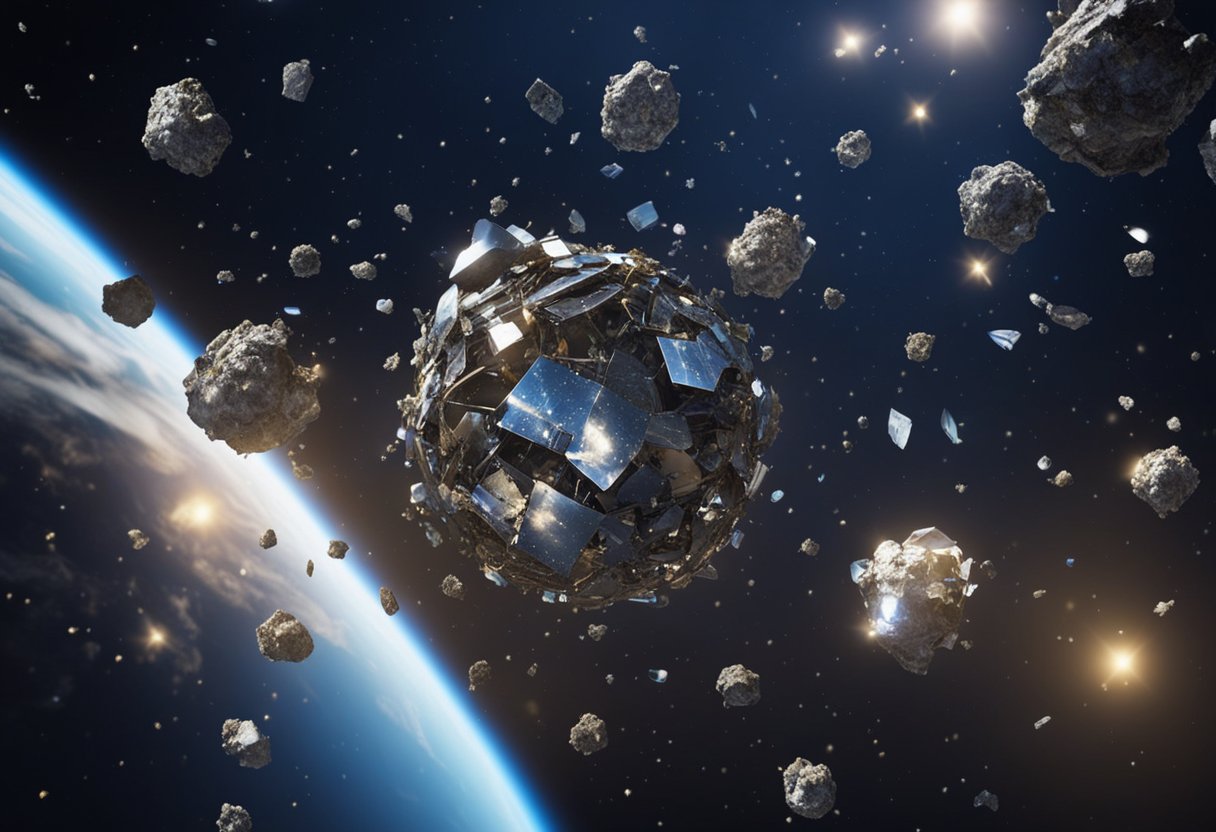
In anticipating the future of our orbital environment, we confront sobering forecasts that intensify the urgency for sustainable space operations.
As stewards of the space environment, we must confront the challenge posed by growing quantities of space debris. Without intervention, the long-term sustainability of outer space is in jeopardy. Future projections suggest that even with strict adherence to debris mitigation guidelines, the existing amount of debris could continue to increase due to accidental collisions or explosions.
The Kessler Syndrome posits a tipping point where the density of debris in Low Earth Orbit (LEO) becomes so high that collisions between objects could cause a cascade effect, exponentially increasing the likelihood of further collisions. This dreaded scenario points to a potentially unrecoverable space environment, thwarting both current missions and future endeavours, such as those proposed by SpaceVoyageVentures.com.
Regulatory bodies and the space community have made concerted efforts to address the growing challenge of orbital debris. We’ve seen coordinated responses and updated guidelines aimed at mitigating its impact on space safety and ensuring sustainable space environments.
The National Aeronautics and Space Administration (NASA) has been at the forefront in the United States, working in unison with entities such as the Inter-Agency Space Debris Coordination Committee (IADC) for global communication and the pursuit of solutions. This collaboration fosters a diverse yet unified approach, pulling expertise from around the world to provide a comprehensive response to the hazards posed by space debris.
Internationally, initiatives by organisations like the IADC, which includes space agencies from 13 member countries, play a pivotal role in harmonising efforts across national borders. Recognising that orbital debris is a global issue requiring a multinational approach, these bodies work towards enhancing space safety not just for current, but also for future space missions.
Mitigation guidelines are regularly revised to adapt to the evolving conditions in space. The latest revisions emphasise the necessity for all spacefaring parties to share in the responsibility of reducing debris. This includes improving the design of spacecraft to minimise the potential for debris generation and the sharing of tracking data to enable safer navigation.
By updating these guidelines, we ensure they remain relevant and effective. Moreover, we encourage new participants in space exploration, such as those involved in space tourism ventures like SpaceVoyageVentures.com, to embrace and adhere to these practices, contributing to a wider culture of space safety and sustainability.
In this section, we aim to clarify some of the most pressing queries regarding the rate of orbital debris accumulation and the methods currently in place to address this growing concern.
The rate of space debris accumulation varies, however, it is widely acknowledged that the proliferation of debris has steadily increased due to activities such as satellite launches and in-orbit explosions. Current estimates suggest that thousands of new debris objects are added to Earth’s orbit annually.
Over recent years, the amount of space debris has escalated significantly. This uptick is attributed to several high-profile anti-satellite tests, along with natural fragmentation events, that have contributed to the increase in both the number and size of debris objects in orbit.
Agencies have developed multiple methodologies for space debris mitigation, which include the minimisation of new debris through design alterations, the use of end-of-life disposal procedures for spacecraft, and the adoption of guidelines to reduce the potential for in-orbit collisions.
Existing space debris removal technologies are in nascent stages and are not yet widely implemented. Whilst initiatives such as capture and deorbit systems show promise, the overall effectiveness of these technologies is still being assessed through various demonstrations and missions.
The principal categories of orbital debris encompass spent rocket stages, defunct satellites, remnants from satellite break-ups, and smaller debris from erosion and collisions. These vary significantly in size, comprising everything from spent satellite parts to paint flecks.
Globally, agencies monitor and track space debris utilising ground-based radar and optical telescopes. There are collaborative efforts, such as the Space Surveillance Network, which share information to maintain an up-to-date catalogue of objects in Earth’s orbit to aid collision avoidance measures.